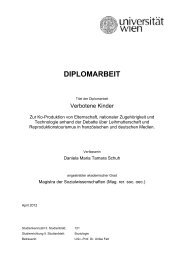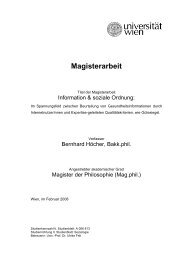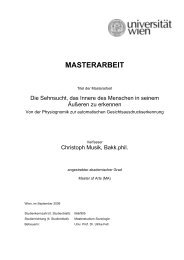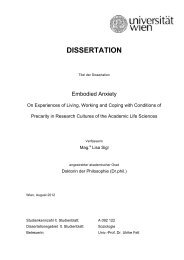MASTERARBEIT - Institut für Wissenschaftsforschung - Universität ...
MASTERARBEIT - Institut für Wissenschaftsforschung - Universität ...
MASTERARBEIT - Institut für Wissenschaftsforschung - Universität ...
Create successful ePaper yourself
Turn your PDF publications into a flip-book with our unique Google optimized e-Paper software.
2.3 literature bodies about and around zeppelins 15<br />
low relation of speed and own length is responsible for the majestic<br />
appearance) they were easy to hit targets at the front. Bombing raids<br />
to Britain proved to be possible yet to be very ineffective. Navigation<br />
was a big issue; airship crews weren’t even able to tell which city they<br />
were bombing. Additionally, many ships were lost - crew losses were<br />
actually higher than the casualties caused on the British side. In the<br />
end, airship operations were discontinued even before the end of the<br />
war. Zeppelin himself had seen the failure of his technology (and<br />
the increasing potential of developing airplanes) coming. During the<br />
last years of his life, he promoted and funded plane developments<br />
for several years before dying in 1917 [11, 182 f.]. With the Versailles<br />
treaty, construction of airships was forbidden. It took several years<br />
for the struggling company (manufacturing other goods in the mean<br />
time) to begin building airships again (now under Hugo Eckener’s<br />
leadership). This second cycle of airships was the time of the famous<br />
big zeppelins that are most commonly remembered (especially LZ-<br />
127 »Graf Zeppelin« and LZ-129 »Hindenburg«) and which were the<br />
first vehicles to provide intercontinental flight services. This short era<br />
lasted only about 10 years, though: With the infamous crash of LZ-129<br />
»Hindenburg« in Lakehurst, New Jersey in 1937 the era of airships<br />
ended. Remaining airships were disassembled and the material used<br />
for airplane production. In Friedrichshafen, one of the succeeding<br />
firms of Luftschiffbau Zeppelin started to build airships again in the<br />
1990s. Nevertheless, Airships remain a means of transportation from<br />
the past and its modern successors (as the one that can be seen on the<br />
Facebook-Screenshot above) have only little practical use – they serve<br />
mostly advertising and sightseeing purposes.<br />
2.3 literature bodies about and around zeppelins<br />
As Zeppelin airships are a famous technology that is still fascinating<br />
to many and known to everybody (at least in Germany), literature<br />
about them is manifold. Surrounding coverage of the issue apart<br />
from the technology itself or praise for its inventor deals with various<br />
issues. As it is a technological artifact of iconic status, all kinds<br />
of reports about it are numerous. While many of them are largely<br />
redundant - the zeppelin history I have shortly summarized above is<br />
part of most accounts along with many ever reprinted photographs<br />
and other materials that are able to cater to the myth those books are<br />
feeding on. If looking for reliable sources for scientific studies, only<br />
such books that give sources and accomplish a certain degree of transparency<br />
and accountability for the claims they make can be considered.<br />
Many of the books on zeppelins are primarily concerned with<br />
depicting the artifact and its fascination respectively its creators and<br />
care little about giving accurate accounts about it and many do not<br />
give sources. Knäusel [30, 10] puts it nicely: He states trivial literature







